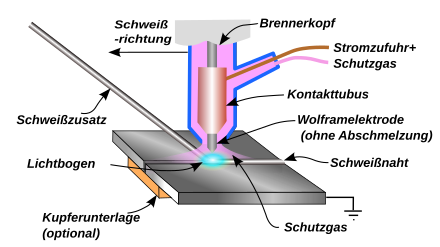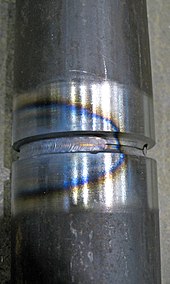Tungsten inert gas welding
The tungsten inert gas welding ( TIG welding Bez USA. Tungsten Inert Gaswelding ( TIG ) or Gas Tungsten Arc Welding (GTAW) , EN ISO 4063: Process 141) is a welding process from the group of arc welding that for arc welding counts , which in turn counts to fusion welding . In TIG welding, an electric arc burns between the workpiece and an electrode made of tungsten . In contrast to other arc processes, the electrode used in TIG welding does not melt due to the high melting point of tungsten. The filler metal is held in the arc in the form of wires or rods and thus melted. In addition, as in all arc processes, the arc melts the base material. So that the melt does not react with the ambient air, protective gases are used that are inert , i.e. do not enter into any chemical reactions with the materials involved. Often it is argon or helium . Particularly high seam quality can be achieved with TIG welding, but it is somewhat slower than the related metal inert gas welding (with melting wire electrode).
TIG welding can be done with or without filler metal. As with gas fusion welding, rod-shaped additives are mostly used for manual welding. However, it is essential to avoid confusion with the gas welding rods, as the chemical compositions differ from one another.
Process principle and applications
TIG welding is characterized by a number of advantages over other fusion welding processes. In connection with TIG pulse welding and TIG alternating current welding, any material suitable for fusion welding can be joined. With TIG welding, there are practically no weld spatter; the health impact from welding fumes is relatively low. A particular advantage of TIG welding is that you do not work with a consumable electrode. The addition of welding consumables and the amperage are therefore decoupled. The welder can adjust his welding current optimally to the welding task and only has to add as much welding consumable as is required at the moment. This makes the process particularly suitable for welding root passes and welding in constrained positions . Due to the relatively low and small-scale heat input, the welding distortion of the workpieces is less than with other processes. Because of the high weld seam quality, the TIG process is preferred where the quality is more important than the welding speed. These are, for example, applications in pipeline and apparatus construction, in power plant construction, the chemical industry or in bicycle frame construction.
The TIG welding system consists of a power source, which in most cases can be switched to direct or alternating current welding, and a welding torch that is connected to the power source by a hose package. The hose package contains the welding current line, the shielding gas supply, the control line and, in the case of larger torches, the supply and return of the cooling water.
Subdivision of the welding process
EN ISO 4063: 2011-03, “Welding and allied processes - List of processes and serial numbers”, distinguishes between 6 subgroups for TIG welding.
- Main group
- 14: Tungsten gas shielded welding
- Subgroups
- 141: Tungsten inert gas welding with solid wire or solid rod filler; TIG welding
- 142: Tungsten inert gas welding without filler material
- 143: Tungsten inert gas welding with filler wire or filler rod
- 145: Tungsten gas shielded welding with reducing gas components in the otherwise inert shielding gas and solid wire or rod filler
- 146: Tungsten shielded gas welding with reducing gas components in the otherwise inert shielding gas and filler wire or filler rod additive
- 147: Tungsten shielding gas welding with active gas components in the otherwise inert shielding gas
Ignition of the arc
There are two ways to ignite the arc, contact and high frequency ignition.
- In historical contact ignition (stroke or scribed ignition), similar to electrode welding, the tungsten electrode is briefly painted on the workpiece - like a match - and thus a short circuit is created. After lifting the electrode from the workpiece, the arc burns between the tungsten electrode and the workpiece. A major disadvantage of this process is that each time it is ignited, some material sticks to the tungsten electrode, which remains as a foreign body in the weld pool due to the higher melting temperatures of the tungsten. For this reason, a separate copper plate, lying on the workpiece, was often used for ignition.
- The high-frequency ignition has almost completely replaced the strike ignition. In the high-frequency ignition of a is using high-voltage pulse generator , which gives a high voltage to the tungsten electrode, the gas between electrode and workpiece are ionized, the arc is ignited thereby. Due to the high internal resistance of the high-voltage pulse generator, no dangerous currents can be generated.
- A variant of the contact ignition is the lift-arc ignition. The electrode is placed directly on the workpiece at the welding point. A small amount of current flows which is insufficient to damage the electrode. When the torch is lifted off, the plasma arc ignites and the electronics of the welding machine increase the current to the welding current strength. The advantage of this method is that it avoids electromagnetic interference that can occur with high-frequency ignition.
Protective gases used
For reasons of cost, the noble gas argon 4.6 is usually used for welding (quality 4.8 is recommended for tantalum and titanium), less often helium or a mixture of both gases. The relatively expensive helium is used because of its better thermal conductivity to increase the heat input. With austenitic stainless steels, small amounts of hydrogen in the shielding gas can reduce the viscosity of the melt and increase the welding speed (this is no longer an inert, but a reducing gas, see planned change to EN ISO 4063).
The shielding gas is fed from the bottle through the hose into the control unit and then to the welding torch on the weld pool. Since the filling pressure can be up to 200 bar, the pressure must be reduced to the correct working pressure using a pressure reducer. As a rule of thumb, the inside diameter of the gas nozzle = 1.5 × the weld pool width. The shielding gas flow rate depends, among other things, on the shape of the seam, material, welding position, shielding gas and nozzle diameter; Information on this can be found in the manufacturer's data sheets. The tacking of butt sutures can be problematic if there is a gap and oxygen has access to the root.
Voltage sources and polarity
In TIG welding, a distinction is made between direct current and alternating current welding. The DC welding with a negatively poled electrode is used for welding of steels of all kinds, non-ferrous metals and their alloys. In contrast, AC welding is mainly used for welding the light metals aluminum and magnesium. In special cases, light metals are also welded with direct current and with a positive electrode. Special welding torches with a very thick tungsten electrode and helium as a protective gas are used. The positive polarity of the tungsten electrode is necessary for light metals, as these usually form a hard oxide layer with a very high melting point (as with aluminum oxide, magnesium oxide) on their surface. This oxide layer is broken when the workpiece is polarized negative, as the workpiece now functions as an electron-emitting pole and negative oxygen ions are carried away.
A further development of TIG welding is welding with pulsating current. With TIG pulse welding , the welding current pulsates between a basic and impulse current with variable frequencies, basic and impulse currents and widths. The pulse frequency, the pulse width and the pulse height can be set separately. TIG pulsing with a variable current curve can only be carried out with a special welding system (welding inverter). The finely adjustable heat input during TIG pulse welding enables good gap bridging, good root welding and good welding in out of position. Weld seam errors at the start and end of the seam, such as in pipe welding, are avoided.
With pulse welding of light metals, it is possible to achieve that only the surface melts, thus preventing the melting through of thin sheets <1.0 mm. With fillet welds, the corner is better captured than with standard welding with constant current. Sheets with a thickness of 0.6 mm can still be butted together, as the stability of the arc and the concentrated heat input allow a small, defined weld pool.
Electrode materials
The DGUV Information 209-049 (handling thoriated tungsten electrodes during tungsten inert gas (TIG), formerly BGI 746) contain information about safe handling of thoriated tungsten electrodes for tungsten inert gas welding and describes the necessary precautions that must be taken to potential hazards by handling these electrodes or to minimize them to an acceptable level. This is necessary because of the low level of radioactivity in the thorium and the harmful dusts of the heavy metal. Due to the availability of tungsten electrodes alloyed with lanthanum or rare earths, the use of thorium-alloyed tungsten electrodes can now be dispensed with.
Osh
Evaluations of workplace measurements have shown that TIG welding is a low-smoke welding process. All welding fume measurement results are below the limit value for A dust of 3 mg / m³. Even with ozone , all values are below the occupational exposure limit (OEL). For chromium (VI) compounds and nickel oxide , the values of all measurement data collectives (different measurement types and points) are far below the previous TRK values.
The BG / BGIA recommendations provide practical information on how to carry out the risk assessment and name protective measures for TIG welding work. If these protective measures are used, the occupational exposure limits can be complied with.
See also
- Langmuir torch , a welding process (arcatom welding) developed by Irving Langmuir in 1924 . The main difference here is the use of the recombination heat of atomic hydrogen .
Individual evidence
- ↑ The right shielding gas and the right setting for TIG welding. Kattex, accessed February 11, 2018 .
- ↑ Reiz-online : TIG primer, summary of the process with recommendations for welding and welding parameters, PDF
- ↑ Klaus-Jürgen Matthes, Erhardt Richter: Welding technology: welding of metallic construction materials. Carl Hanser Verlag, 2008, ISBN 978-3-446-41422-8 (section: Wig welding. Limited preview in the Google book search).
- ↑ a b German Statutory Accident Insurance e. V. (DGUV): DGUV Information 213-712 - BG / BGIA recommendations for risk assessment according to the Hazardous Substances Ordinance: Tungsten inert gas welding (TIG welding). Retrieved November 19, 2019 .


